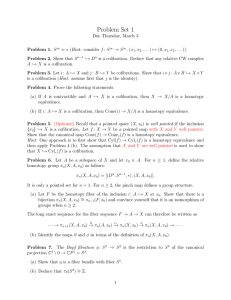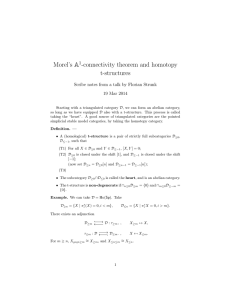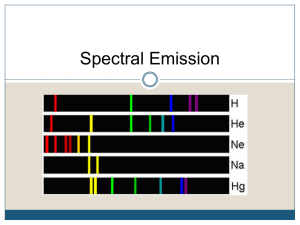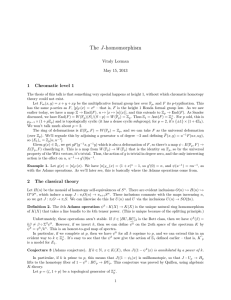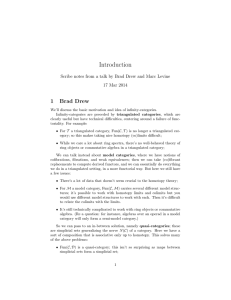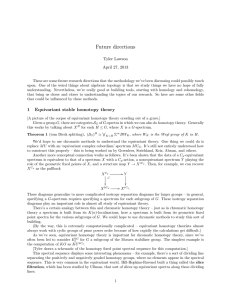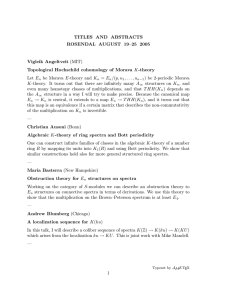The K(n)-local sphere 1 Goals Johan Konter
advertisement
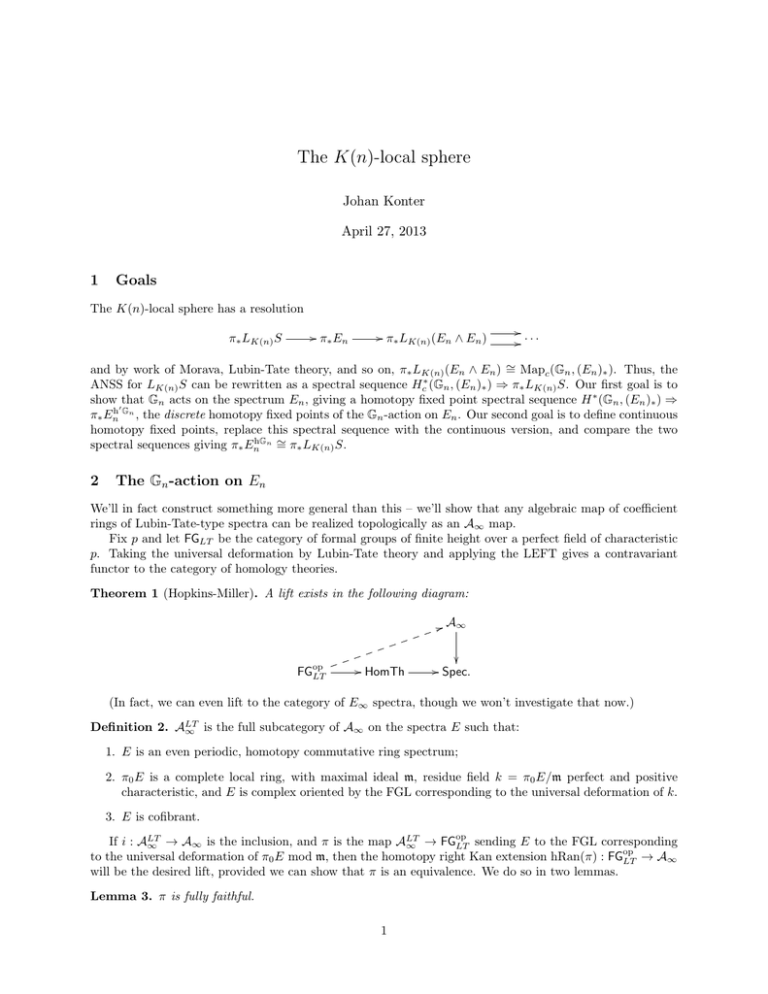
The K(n)-local sphere Johan Konter April 27, 2013 1 Goals The K(n)-local sphere has a resolution π∗ LK(n) S / π∗ E n / π∗ LK(n) (En ∧ En ) / / ··· and by work of Morava, Lubin-Tate theory, and so on, π∗ LK(n) (En ∧ En ) ∼ = Mapc (Gn , (En )∗ ). Thus, the ANSS for LK(n) S can be rewritten as a spectral sequence Hc∗ (Gn , (En )∗ ) ⇒ π∗ LK(n) S. Our first goal is to show that Gn acts on the spectrum En , giving a homotopy fixed point spectral sequence H ∗ (Gn , (En )∗ ) ⇒ 0 π∗ Enh Gn , the discrete homotopy fixed points of the Gn -action on En . Our second goal is to define continuous homotopy fixed points, replace this spectral sequence with the continuous version, and compare the two spectral sequences giving π∗ EnhGn ∼ = π∗ LK(n) S. 2 The Gn -action on En We’ll in fact construct something more general than this – we’ll show that any algebraic map of coefficient rings of Lubin-Tate-type spectra can be realized topologically as an A∞ map. Fix p and let FGLT be the category of formal groups of finite height over a perfect field of characteristic p. Taking the universal deformation by Lubin-Tate theory and applying the LEFT gives a contravariant functor to the category of homology theories. Theorem 1 (Hopkins-Miller). A lift exists in the following diagram: 4 A∞ FGop LT / HomTh / Spec. (In fact, we can even lift to the category of E∞ spectra, though we won’t investigate that now.) Definition 2. ALT ∞ is the full subcategory of A∞ on the spectra E such that: 1. E is an even periodic, homotopy commutative ring spectrum; 2. π0 E is a complete local ring, with maximal ideal m, residue field k = π0 E/m perfect and positive characteristic, and E is complex oriented by the FGL corresponding to the universal deformation of k. 3. E is cofibrant. op LT If i : ALT ∞ → A∞ is the inclusion, and π is the map A∞ → FGLT sending E to the FGL corresponding to the universal deformation of π0 E mod m, then the homotopy right Kan extension hRan(π) : FGop LT → A∞ will be the desired lift, provided we can show that π is an equivalence. We do so in two lemmas. Lemma 3. π is fully faithful. 1 2 Proof. Let E, F ∈ ALT ∞ with formal groups Γ1 and Γ2 , and fix an A∞ -operad C. Consider the simplicial resolution o o F o CF o CCF o ··· o and let Y • be the cosimplicial object Y n = C−Alg(C n+1 F, E). Then Tot Y • ' C−Alg(F, E). There’s a Bousfield-Kan spectral sequence π s πt Y • ⇒ πt−s Tot Y • , where π s is cohomotopy groups. A map of ring spectra F → E corresponds to an element of the equalizer of the two maps from π0 Y 0 to π0 Y 1 , that is, an element of E20,0 . The obstructions to realizing this as an A∞ map occur in the groups E2s,s−1 , that is, along the Adams (−1)-line. One does some computations to show that the spectral sequence becomes zero at the E2 -page. Thus we have 0,0 0,0 ∼ π0 C−Alg(F, E) = E∞ = E∞ −Alg(E∗ F, E∗ ). = E2 ∼ By algebra and our assumptions, this is just Hom(F∗ , E∗ ) ∼ = FGLT (Γ1 , Γ2 ). Lemma 4. π is essentially surjective. Proof. . Let Γ ∈ FGLT corresponding to the spectrum E via Lubin-Tate; we want to show that E has a A∞ structure. It suffices to construct a map / EE C L ~ with C an A∞ -operad, EE [n] = S(E (n) , E) and L the linear isometries operad. (We’re using the LMS construction of spectra, in which the spectrum structure of E is precisely a map from its endomorphism operad to L.) Let A be an A∞ -operad and C∗ → Sing A a cofibrant resolution, giving a map |C∗ | → A. Define Y n = (Operad ↓ L)(Cn , EE ). Again we examine the Bousfield-Kan spectral sequence for π∗ Tot Y • and observe that everything vanishes on the E2 page besides E20,0 . By the same argument as in the previous lemma, π0 (Operad ↓ L)(C, EE ) ∼ = Hom(π0 C, π0 EE ), and so the desired map C → EE exists, giving E an A∞ structure. This proves the theorem. 3 The E∞ case Definition 5. The moduli space of a commutative E∗ E-comodule algebra A (that is, an E∗ E-comodule with a compatible commutative E∗ -algebra structure) is T M (A), the classifying space of the category of E∞ -spectra X with E∗ X ∼ = A and E∗ -isomorphisms. Theorem 6 (Goerss-Hopkins). If Γ is a FGL giving the spectrum E by Lubin-Tate, then T M (E∗ E) has homotopy type B AutE∗ −Alg (E∗ E) ' B Aut(Γ). This is proved in a similar way as before, though the obstruction theory is harder. The above allows us to lift the Gn -action on (En )∗ to one on En . 4 Homotopy fixed points Definition 7. Let U ⊆ Gn be an open subgroup. Then we define EnhU = Tot π ∗ LK(n) (πGn /U En ∧ En∧• ). Here, for X : J → hE a diagram, we define Y F (| Sing E(Xjn , Xjn−1 )αn | × · · · × | Sing E(Xj1 , Xj0 )α0 |, Xj0 ). πn X = α α n 1 [jn → jn−1 →··· →j 0 ]∈N (J )n 4. HOMOTOPY FIXED POINTS 3 There’s a spectral sequence π s [Z, π ∗ LK(n) CGn /U ]t ⇒ (EnhU )t+s Z. With some work, one can show that this E2 page is precisely Hcs (U, Ent Z).



